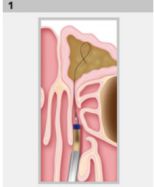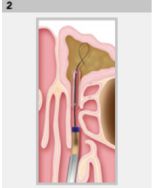Sinus surgery is a common ENT procedure, reserved for those patients who fail to respond to appropriate medical therapy for sinusitis. Recently, there have been multiple media reports regarding balloon sinuplasty, a new technique for sinus surgeons. As with any technique, there are advantages and disadvantages, and this newsletter is written to help separate the truth from the hype. Balloon sinuplasty incorporates the ideas of angioplasty into sinus surgery.
Using guidewires under endoscopic and fluoroscopic visualization, the balloon can be guided into the desired sinus. It is then inflated, permanently dilating the natural opening or ostium to the sinus and allowing it to drain normally.
These diagrams show an example of frontal sinus balloon sinuplasty:

To gain initial sinus access, the Sinus Guide Catheter is introduced into the target sinus under endoscopic visualization. A flexible Sinus Guidewire is introduced through the Sinus Guide Catheter and gently advanced into the target sinus under fluoroscopic guidance.

The Sinus Balloon Catheter tracks smoothly over the Sinus Guidewire and positioned across the blocked ostium. Using fluoroscopy, the position of the Sinus Balloon Catheter is confirmed. It is gradually inflated to gently restructure the blocked ostium.

The Balloon Sinuplasty™ system is removed, leaving the ostium open and allowing the return of normal sinus drainage and function.
There is little to no disruption to mucosal lining.
The major benefit of balloon sinuplasty is minimal trauma to tissue, resulting in minimal pain, very quick recovery, minimal bleeding, and no need for packing. It has very encouraging 1-2 year results in studies as well, showing patency rates of the sinuses over 90%. Balloon sinuplasty is currently indicated for sphenoid, maxillary, and frontal sinus obstruction. While there is a learning curve, in general the procedure takes about the same or less time than standard sinus surgery. When appropriate, this can be a very valuable technique for the sinus surgeon and the patient.
There are several limiting factors, however. Balloon sinuplasty is not indicated for the ethmoid sinuses, which frequently require surgery in the setting of chronic sinusitis. If ethmoid surgery is required at the same time as balloon sinuplasty, it may necessitate packing, and limit the pain and bleeding benefits. There is additional expense because of specialized instrumentation, which currently in Grand Rapids is not available at any outpatient surgical centers. There is also radiation exposure to the patient and surgeon because of fluoroscopy, although this generally is a low level.
While media reports have been discussing this “new” procedure, the physicians at the Ear, Nose, and Throat Center have all been trained in the technique, with these procedures being done through our office for over a year. While not right for every patient, it can be a useful tool for difficult sinus cases, in conjunction with other advanced techniques such as powered microdebriders, image-guided surgery, and use of absorbable packing. We welcome any questions about these newer techniques as well as about your patients with difficult sinus disease.